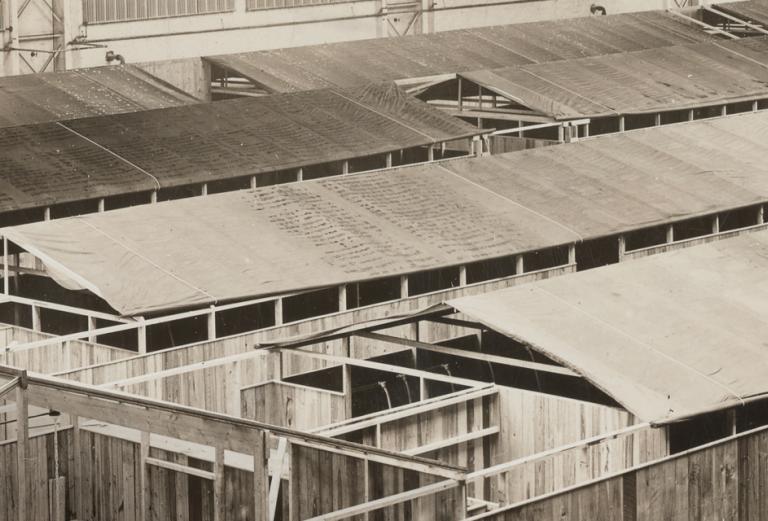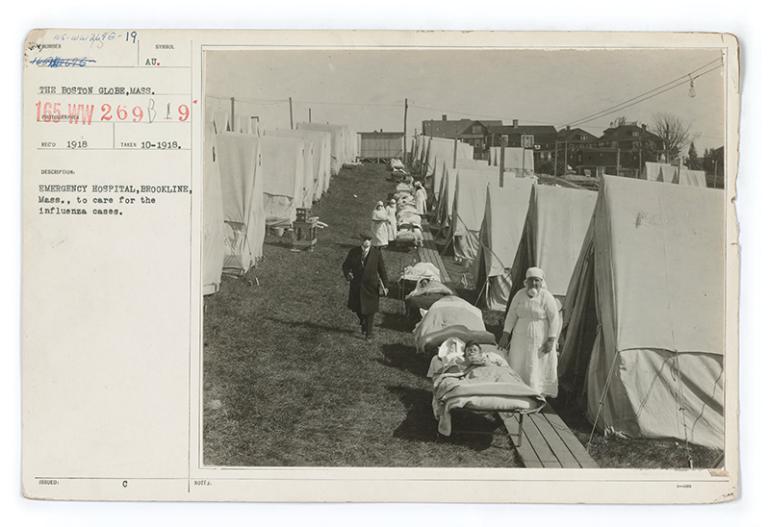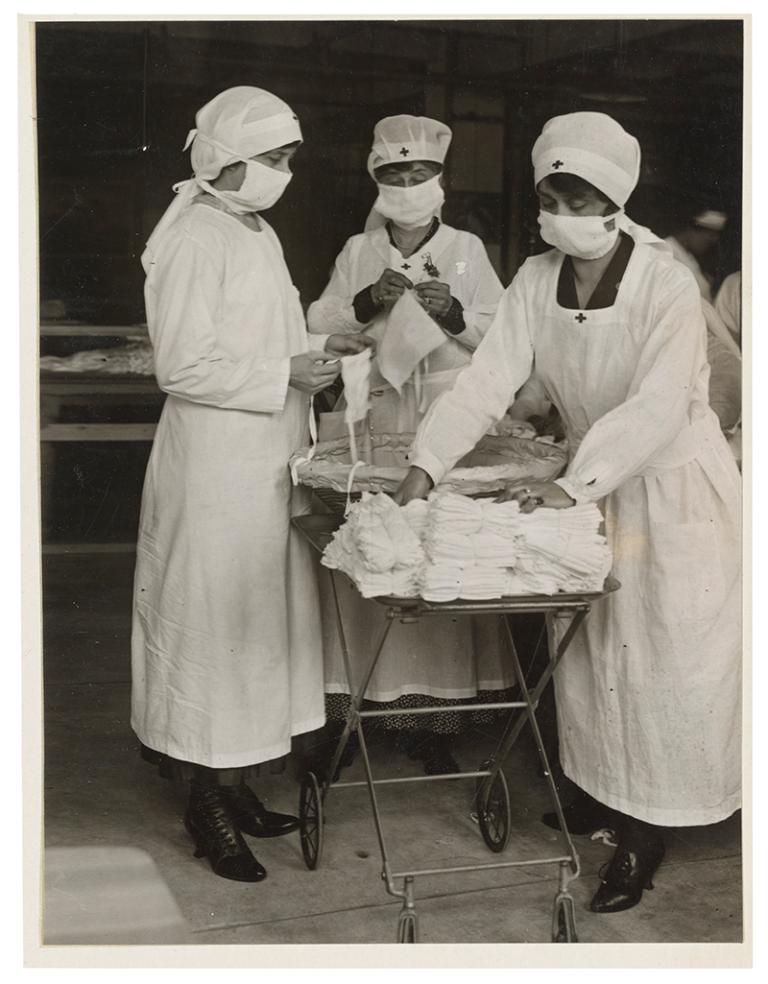In the Grip of a Disease
During the 1918 influenza pandemic, HMS students, faculty, and alumni stepped in to care for the afflicted and research the cause
- Feature

Harvard President A. Lawrence Lowell was faced with a dilemma. It was toward the end of World War I, and a severe pandemic had roared into Massachusetts. Should the University hold classes as scheduled?
Lowell consulted with medical school faculty. Henry Asbury Christian, the Hersey Professor of the Theory and Practice of Physic, “felt as you do,” Lowell wrote to his cousin Joseph Lee, of Cohasset, in September 1918, “that we had better postpone the opening. On the other hand, Doctor Rosenau thinks it would be a mistake for us not to open on time,” referring to Milton Joseph Rosenau, a professor of preventive medicine and hygiene at the School.
Lowell laid out the case for both options, ultimately concluding that “as the epidemic has spread all over the country, there would be no increased exposure from bringing the students here.” So the fall term began on schedule, with a few restrictions, including the suspension of classes of more than fifty students.
The Spanish flu—so named because neutral Spain’s early mortality reports, undiminished by military censors, made the country seem especially hard-hit—first appeared in March 1918, with a deadlier second wave starting in the fall of that year and lasting until the spring of 1919. Lesser recurrences popped up as long as three years later. The avian-derived H1N1 virus that caused this pandemic would ultimately infect around 500 million people, or a third of the world’s population, and contribute to as many as 100 million deaths—up to five times as many as “the war to end all wars.”
Two by sea
Greater Boston was ground zero for the contagion’s resurgence in the United States. On Tuesday, August 27, two U.S. Navy seamen stationed at Commonwealth Pier were admitted to the sick bay with flu-like symptoms. By the end of the following day, eight more sailors had joined them. On Friday, fifty-eight beds were filled, and within a week hundreds of new cases were crowding waterfront infirmaries. Morgues were at or beyond capacity, and gravediggers were seen dumping the dead into the ground unprotected so their caskets could be used again. The flu struck its victims like a bolt from the blue, with people who weren’t attentive to subtle symptoms sometimes reported collapsing mid-stride.

Proximity put HMS students and faculty on the frontlines in the battle against the disease. Even as their classmates and colleagues became involved in the conflict, those who remained at home attended to patients, educated the public, and delved into the etiology and treatment of this calamitous new phenomenon.
“The devastating epidemic of influenza not only imposed upon the teaching force and students their share of illness and incapacity for work,” wrote David Edsall, the freshly appointed dean of HMS, in his 1918 annual report, “it has made also extraordinary demands upon all the clinical teachers in meeting the universal need for medical care and it led to a public call for assistance from senior medical students which the students met promptly and admirably.”
Fourth-year students suspended their classwork to help look after their peers, around sixty of whom were in the College’s Stillman Infirmary by October with “the grip,” as influenza was then commonly called. By the time the spring semester began, five of the hospitalized students had died, along with three teachers.
Several emergency hospitals, such as this one in Brookline, Massachusetts, were set up to care for patients during the 1918 flu pandemic. This photo appeared in the Boston Globe in October 1918.
About a dozen fourth-years were installed as medical officers in various posts around campus. One oversaw the infirmary; of the others, the Harvard Crimson reported, “one is in charge of the suspected cases isolated in Standish Hall, one is acting as special assistant to Dr. Bailey, University physician, and another is stationed at the Locker Building, where the [U.S. War Department’s Student Army Training Corps’] physical examinations are being held, to watch for new cases.”
HMS students set to graduate that year were also conscripted by various towns and cities around Boston. “We have received splendid reports from physicians with whom these students have worked,” wrote J.J. Carroll of the Emergency Health Committee for the State Committee on Public Safety, to Edsall in late October, after the students were released from duty. “They have been faithful and conscientious and we are most grateful for their assistance during the past few weeks.”
The Administrative Board voted that these absent students should receive a “pass mark” for their section work that term, though they were still on the hook for exams.
Catalog of symptoms
In early September, Edwin Allen Locke, MD 1901, an HMS assistant professor of medicine, set up an influenza ward in the South End’s Boston City Hospital, which treated 2,300 patients. Among the 675 who died were nine of eighty nurses infected and two of twenty sick doctors.
“Too much cannot be said for the heroism of our physicians and nurses who, despite depleted numbers owing to the war, worked on under conditions beyond description,” wrote the hospital’s board of trustees in that year’s annual report.
The conditions may have been hard to describe, but Locke, George E. Rönne, MD 1918, and Herman Lande, MD 1918, recounted for the flu itself a “picture of unusual definiteness” in a January 1919 paper based on their “intensive study” of patients seen in the hospital’s Harvard Teaching Service.
The paper, published in the Boston Medical and Surgical Journal, noted that 68 percent of the cases of this “acute catarrhal infection of the respiratory tract” occurred in patients between 20 and 40 years old, and that the overall mortality rate of 2 percent shot to nearly 52 percent for those with flu complicated by pneumonia. Among the symptoms were chills, headache, and “profuse sweats,” “malaise and prostration,” “constant agonizing pains in the back, legs and frequently in the joints,” “very acute hyperalgesia of the skin,” and a “burning pain under the sternum which might be felt from the larynx to the lower limits of the thorax” and which was “greatly aggravated by cough.” Their depiction of those with secondary pneumonia was even more grim, and included “overwhelming toxemia” leading to delirium or, more often, stupor, and nausea, extreme bloating, gas, and sometimes “very violent” diarrhea. The intense cyanosis that led to the flu being nicknamed the “Purple Death” was the “most important single prognostic sign [of] … almost certain fatal termination.”
Locke and his colleagues had no cure at their disposal but noted a treatment that “yielded results which are most striking” when employed by the doctors who had devised it at the Chelsea Naval Hospital. The preliminary report from the Navy’s Lee W. McGuire, a lieutenant commander, and Medical Corps Lieutenant William Rufus Redden, MD 1917, appeared in the October 1918 issue of the American Journal of Public Health. The report documented their work injecting patients with serum from those “convalescing from pneumonia, following an attack of influenza.” The two doctors claimed the serum shortened the course of the disease and lowered mortality by 30 percent in the thirty-seven patients who received it.
Their final report, published in 1919 in the Journal of American Medicine (JAMA), claimed a reduction in mortality from 38 percent to 4 percent in a study of 151 patients. For this work, “and for general service at the hospital,” the two men received the Navy Cross, the service’s second-highest decoration awarded for valor in combat.
Mystery agent
Though the British physician Edward Jenner had developed a smallpox vaccine in 1796, it wasn’t until almost a century later that the word “virus” came to be applied to certain pathogens that were known to be smaller than bacteria. Before 1918, only a few other viruses had been identified, including those causing yellow fever, rabies, and polio, so when influenza arrived researchers weren’t sure what they were looking for. Because a lot of Pfeiffer’s bacillus, a gram-negative, anaerobic bacterium of the family Pasteurellaceae, was showing up in patients’ samples, most doctors thought it was the cause of the outbreak. The debate continued through the first year of the pandemic.

Rosenau was prominent in the effort to find an answer. He had considered the virus hypothesis in the past, during an earlier iteration of influenza that may have been a “herald” event for the 1918 pandemic. As early as January 1916, after a new strain of flu had begun to sharply increase death rates in the United States, Rosenau had organized a symposium to explore the idea that the illness might be viral in origin. No definitive answer was agreed upon, but at the height of the second wave, he renewed his interest in the topic.
Under the auspices of the U.S. Public Health Service and the Navy, Rosenau and his colleagues, in an effort to “determine the mode of spread of influenza,” tried to infect military volunteers with Pfeiffer’s bacillus at a makeshift infirmary on Gallops Island in Boston Harbor. Though human experiments were then seen as acceptable, in a paper later published in JAMA, Rosenau noted that the team “proceeded rather cautiously at first by administering a pure culture” of the bacterium.
When the “trials proved negative,” he wrote, “we became bolder.” The scientists gave each of the volunteers “a very large quantity of a mixture of thirteen different strains of the Pfeiffer bacillus, some of them obtained recently from the lungs at necropsy.” They also inoculated the men with specimens taken from the throats and noses of influenza patients and later with the patients’ blood. Still no symptoms, so next the volunteers shook hands with, talked with, and were coughed on by the actively ill. They remained healthy.
“We entered the outbreak with a notion that we knew the cause of the disease, and were quite sure we knew how it was transmitted from person to person,” Rosenau wrote. “Perhaps, if we have learned anything, it is that we are not quite sure what we know about the disease.”
The controversy was settled by 1921, when Warren T. Vaughan, an assistant in preventive medicine and hygiene at HMS, wrote a 245-page book parsing the 1918 pandemic and “the life and habits of the influenza virus.”
Perhaps, if we have learned anything, it is that we are not quite sure what we know about the disease.
Published by the American Journal of Hygiene, the study compared the Spanish flu to another outbreak that was first reported in Russia and by 1890 had reached the United States. Now thought to be an H3N8 or H2N2 strain, that virus killed about one million people worldwide and was much on the minds of physicians and researchers contending with the 1918 disease. Vaughan, who based his research in part on a “sickness census” of ten thousand Boston households he and fourteen assistants undertook in 1920, noted his indebtedness to his chief, Rosenau, for “the inspiration to carry on this investigation.”
Other Harvard-based studies examined largely overlooked aspects of the pandemic. Among them was a 1919 JAMA paper on influenza-linked psychoses by psychiatrist Karl Menninger, MD 1917, based on work he had done at the Boston Psychopathic Hospital after he graduated. A year later, in the Archives of Neurology and Psychiatry, Menninger described three case studies, all of which, he concluded, indicated influenza-induced “schizophrenia hebephrenica.”
The 1918 pandemic led to foundational research examining the spread and containment of disease and to advancements in the treatment of influenza. It revolutionized epidemiology and public health by showing the value of tracking diseases and sharing centralized information. It spurred the professionalization of medicine, changes in the nascent health-insurance industry, and even the cause of women’s rights. And despite the personal risks required, the demands of their wartime government, and the tragedy they saw all around them—including among their colleagues and in their families—Harvard scientists contributed to these societal shifts by turning greater Boston into a real-world classroom and a living laboratory.
“In certain ways the teaching necessarily suffered temporarily,” Edsall wrote in his annual report, but “we may reasonably believe that this loss was offset by the service rendered in a crisis.”
Elizabeth Gehrman is a Boston-based writer.
Images are from the U.S. National Archives Catalog. Individual file numbers are 165-WW-269B-59 (top); 165-WW-269B-19 (Brookline hospital); 165-WW-269B-37 (Red Cross workers).